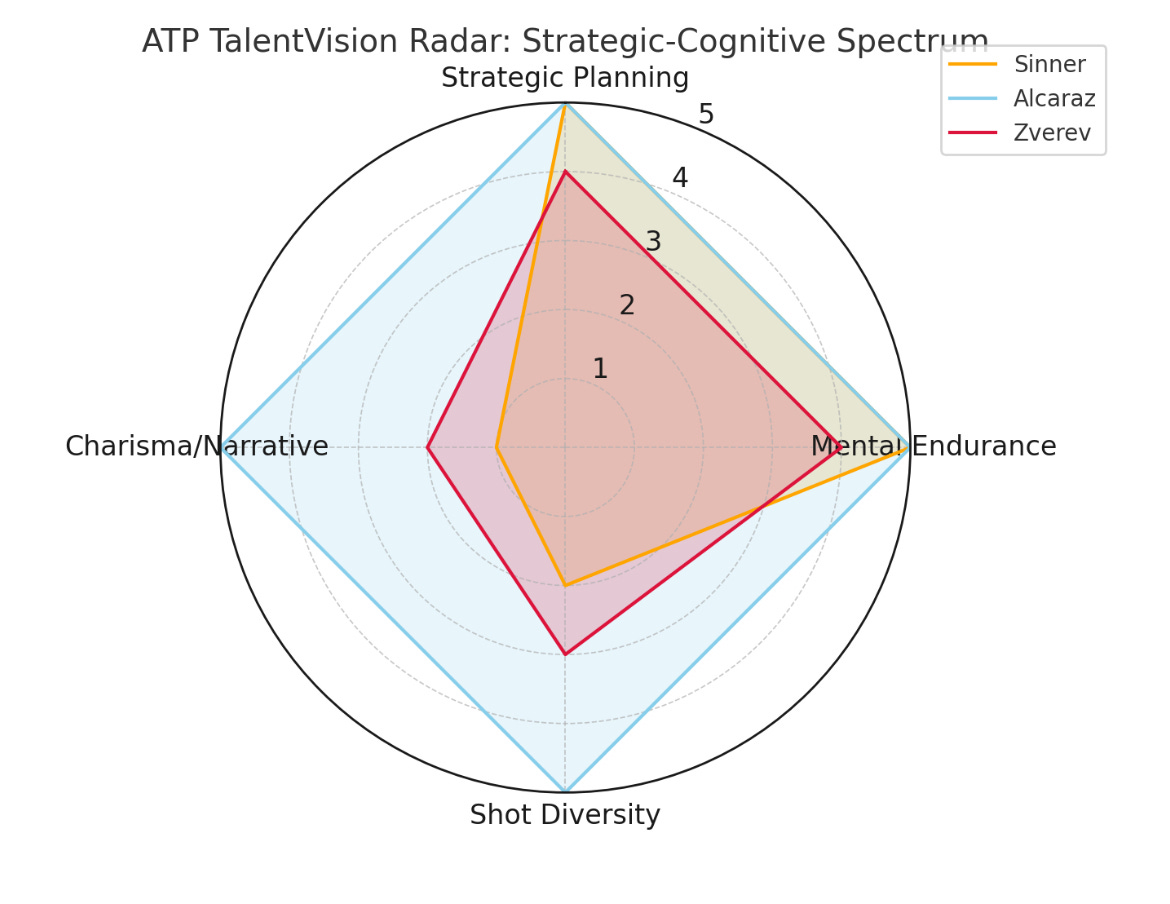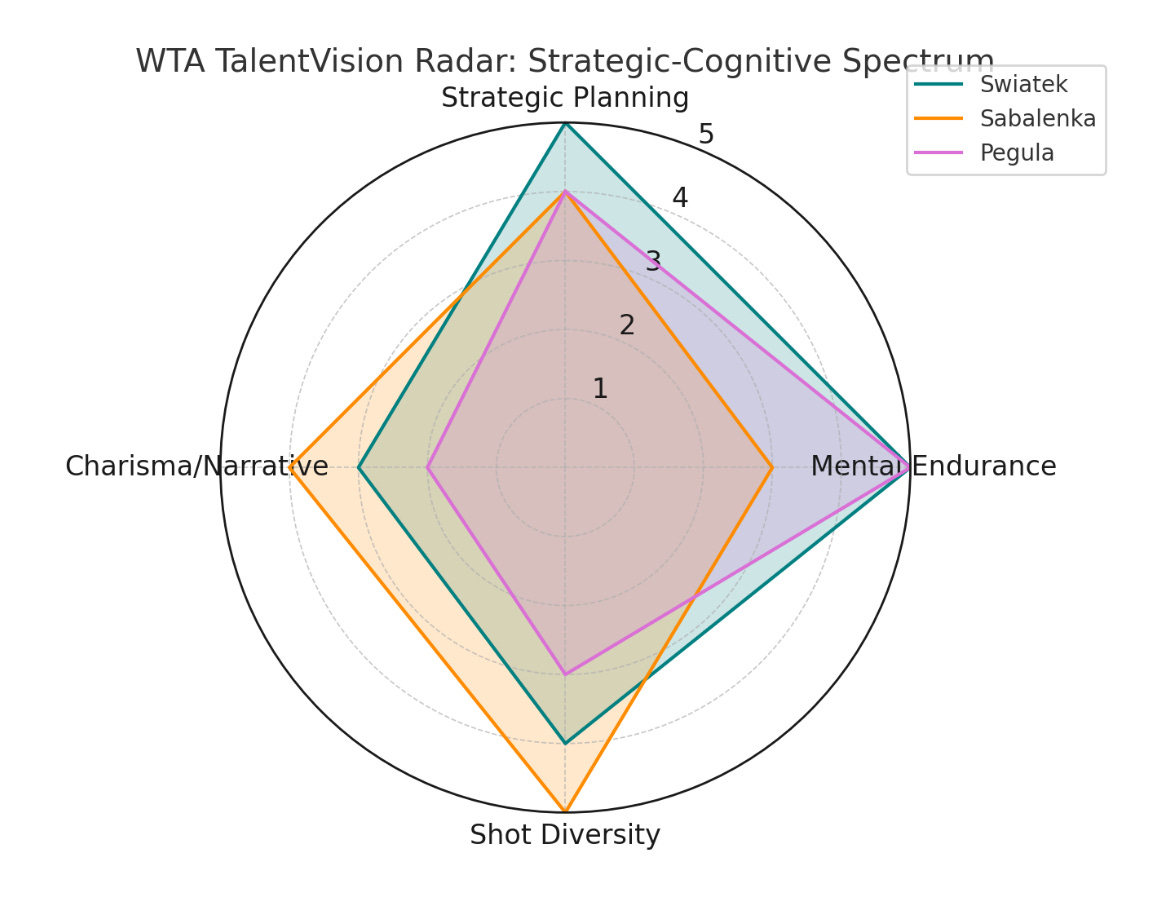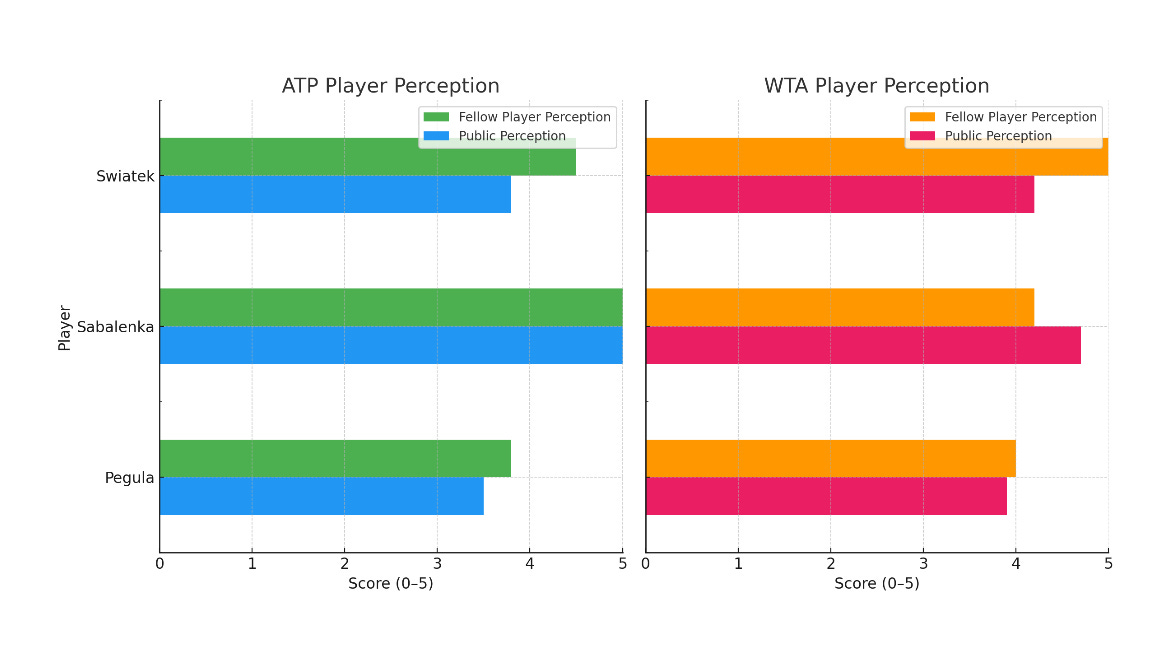MCAI Tennis Vision: The Cognitive Architecture of Tennis Champions
The Cognitive Architecture of Champions
Executive Summary
Tennis is one of the most cognitively analyzable sports in the world. Every match is a series of decisions under pressure—where timing, emotion, adaptability, and perception intersect. Players are not just executing technique; they are simulating opponents, recalibrating strategy, and managing narrative momentum in real time. These are precisely the conditions where Cognitive Artificial Intelligence can reveal what traditional analytics cannot: the internal architecture of judgment.
MindCast AI LLC develops Cognitive Digital Twins (CDTs) to simulate how individuals and institutions think, decide, and adapt under stress. Our proprietary technology—MindCast Cognitive Artificial Intelligence (MCAI)—models decision-making patterns across diverse sectors by preserving the structure of foresight, identity, and emotional regulation. It is patent pending and designed to forecast behavior, simulate perception, and decode risks.
MCAI powers forecasting and strategy in the following markets:
Investment Simulation and Risk Intelligence
Litigation Strategy and Narrative Forecasting
Commercial Real Estate Reputational Mapping
Legacy Continuity for Founders, Universities, and Institutions
Sports Intelligence
Performance Cognition in Classical Piano
Regulatory Intelligence and Decision Making
Public Perception Benchmarking and Monitoring
At the center of every simulation is a Cognitive Digital Twin—trained on language, behavior, and decision records—built to preserve how an agent processes reality. MCAI does not just project outcomes; it simulates how they are perceived and why they emerge.
TennisVision Simulation – April 2025
This study introduces TennisVision, MindCast AI’s TalentVision module adapted specifically for professional tennis. TennisVision simulates the mental architecture, emotional calibration, and strategic foresight of elite players—not just as athletes, but as cognitive performers under extreme pressure. It models each player’s Cognitive Digital Twin (CDT), enabling insight into their internal decision logic, adaptability, and perception dynamics across time.
In this simulation, we analyze the top three ATP and WTA players as of April 2025:
Jannik Sinner, Carlos Alcaraz, and Alexander Zverev
Iga Swiatek, Aryna Sabalenka, and Jessica Pegula
Each player is evaluated using MCAI’s core simulation layers:
Strategic Identity – their foundational mode of cognition and match control
Decision Architecture – how they structure points, shift momentum, and manage risk
Cognitive-Motor Fidelity (CMF) – the alignment between intention and action under pressure
Action-Language Integrity (ALI) – coherence between public expression and on-court behavior
Narrative Reflex and Perception Simulation – how they are viewed by fellow players and the public
TennisVision goes beyond performance statistics. It reveals how each athlete thinks, adapts, and transmits identity—making it a breakthrough tool for coaches, analysts, sports psychologists, and institutions looking to decode the future of talent.
Player CDT Simulations
Jannik Sinner – “The Tactical Glacier”
Strategic Identity: Sinner plays the long game—literally and metaphorically. He’s not flashy, but relentless, metabolizing pace and pressure through a methodical rhythm of strategic ball placement, timing, and court geometry control. His brand of excellence lies in tactical patience and emotional restraint, which disorients more emotional or risk-prone opponents.
Decision Architecture: Sinner does not chase winners. He accumulates them by mapping out patterns mid-match and making near-invisible shifts in depth, spin, or tempo. His decisions are low-variance and high-percentage. He’s a system optimizer—he treats every match like a slowly converging equation.
Cognitive-Motor Fidelity (CMF): 9.6
Action-Language Integrity (ALI): 9.4
Narrative Reflex: He’s not trying to become a celebrity. The story Sinner tells—through performance—is about functional mastery, not charisma. His quiet dominance unsettles louder rivals.
Operating IQ Estimate: 155–160
Carlos Alcaraz – “The Creative Reactor”
Strategic Identity: Alcaraz fuses the emotional explosiveness of youth with an uncanny ability to improvise. He’s the only top player who can make a high-risk option feel inevitable—because for him, it often is. He plays like a jazz musician: structured chaos.
Decision Architecture: His genius is in deviation—not from logic, but from predictability. He processes live feedback (opponent position, crowd energy, surface condition) and pivots. He can switch from moonballs to drop shots to net rushes within a single rally—and not lose control.
Cognitive-Motor Fidelity (CMF): 9.3
Action-Language Integrity (ALI): 8.7
Narrative Reflex: He’s written as the “heir to Nadal,” but his actual story is self-reinvention—a player who doesn’t follow paths, he forges momentum arcs.
Operating IQ Estimate: 150–160
Alexander Zverev – “The Risk-Averse Commander”
Strategic Identity: Zverev is a defensive strategist in a server’s body. He plays with the mindset of a general who believes in preserving control. He thrives when dictating pace, but is prone to tactical inertia when pressed to innovate.
Decision Architecture: He builds matches like fortresses—solid, high walls, few leaks. But this also makes him vulnerable to fluid, creative opponents who bypass linearity.
Cognitive-Motor Fidelity (CMF): 8.4
Action-Language Integrity (ALI): 7.9
Narrative Reflex: Zverev’s story is about control—but he’s often haunted by the fear of loss, which limits his creative range under pressure.
Operating IQ Estimate: 145–150
Aryna Sabalenka – “The Volatile Catalyst”
Strategic Identity: Sabalenka plays like a tectonic force—every swing is designed to end the point. Her core identity is built around power, momentum, and emotional velocity. She channels volatility into shot-making and thrives when she believes. But belief is the hinge.
Decision Architecture: She often commits to high-risk, high-reward shot patterns early in rallies. When confidence is high, these choices destabilize her opponents. When it’s low, the same patterns collapse under inconsistency. Her biggest edge is also her biggest threat: emotional propulsion.
Cognitive-Motor Fidelity (CMF): 8.9
Action-Language Integrity (ALI): 8.1
Narrative Reflex: Sabalenka is rewriting the “emotionally fragile power hitter” arc into one of emotional weaponization. She doesn’t hide volatility—she sharpens it.
Operating IQ Estimate: 145–150
Iga Swiatek – “The Tactical Oracle”
Strategic Identity: Swiatek is a systems engineer in tennis shoes. She thinks in frameworks: every point has a conditional logic tree, and she prunes branches mid-rally. Her style reflects long-term planning, short-term calculation, and emotional minimalism.
Decision Architecture: She optimizes shots by probability, not instinct. Swiatek sequences shots to extract errors—not just from opponents’ technique, but their mental maps. Her drop shots are psychological traps. Her angles are pressure algorithms.
Cognitive-Motor Fidelity (CMF): 9.7
Action-Language Integrity (ALI): 9.6
Narrative Reflex: Swiatek has taken the mantle of post-Barty structural dominance—but her story is about internal architecture. She doesn’t chase rivalries; she eliminates variables.
Operating IQ Estimate: 160–165
Jessica Pegula – “The Systemic Stabilizer”
Strategic Identity: Pegula is the blueprint for consistency. Her identity is built on baseline integrity—she’s not trying to dominate, but to eliminate variance. She is the control group in a chaotic sport.
Decision Architecture: She uses tempo and discipline to drag opponents into long rallies where risk becomes punishment. She rarely changes patterns unless it’s a strategic necessity—and that caution keeps her efficient, but also limits disruption potential.
Cognitive-Motor Fidelity (CMF): 8.6
Action-Language Integrity (ALI): 8.8
Narrative Reflex: She’s fighting two stories: being underestimated and being considered “solid but unspectacular.” Her counter-narrative is one of quiet repetition: show up, deliver, evolve.
Operating IQ Estimate: 145–150
Commentary & Insights
ATP Summary:
Carlos Alcaraz leads both in peer respect and public appeal—he’s seen as the future by players and the media alike.
Jannik Sinner commands strong respect among fellow players for his discipline and clean game, though his public profile remains understated.
Alexander Zverev is respected but not revered—his public image has not fully recovered from past controversies, and fellow players see him as solid but not generational.
WTA Summary:
Iga Swiatek is the clear peer favorite—seen as the mental and strategic benchmark of the tour, though her public persona is more reserved.
Aryna Sabalenka scores highest in public perception due to her charisma and emotional intensity, but fellow players recognize her volatility.
Jessica Pegula earns quiet respect among players for her steadiness, though her low-key image keeps her under the public radar.
Use Case for Rising Athletes
Want to be like Sinner? Build a game rooted in quiet dominance—precise, consistent, and emotionally unshakeable. Sinner proves you don’t need flair to win—just discipline, depth, and a mind that doesn’t flinch.
Prefer the Alcaraz path? Fuse athletic explosiveness with instinctive creativity. Alcaraz thrives on energy, improvisation, and momentum—but always with a tactical compass underneath.
Aspire to Zverev’s model? Control the match through structure, rhythm, and physical presence. Zverev relies on big serving and baseline stability, showing that predictability can be power—if you build it on discipline.
Want to be like Swiatek? Master mental composure, point construction, and consistency under pressure. Swiatek’s dominance comes not from volume, but from precise execution and inner stillness.
Prefer the Sabalenka path? Turn emotional intensity and raw power into your advantage. When channeled, Sabalenka’s aggression becomes momentum—turning matches into one-woman storms.
Aspire to Pegula’s model? Be the player no one can shake—steady, tactically sound, and impossible to rattle. Pegula wins by minimizing mistakes, staying grounded, and outlasting chaos.
Perception Simulation Summary
ATP Perception:
Alcaraz is revered across peers and public.
Sinner commands deep respect, quieter public profile.
Zverev respected but narratively limited.
WTA Perception:
Swiatek is the strategic standard.
Sabalenka draws attention with volatility.
Pegula flies under radar but earns quiet trust.
MCAI reveals where external narrative diverges from internal perception—a vital tool for athlete branding, media strategy, and personal growth.
Conclusion: Modeling the Future of Tennis Intelligence
The TennisVision simulation powered by MindCast Cognitive Artificial Intelligence demonstrates that elite tennis is as much a cognitive discipline as it is a physical one. From Swiatek’s systemic precision to Alcaraz’s improvisational brilliance, each player operates within a unique mental architecture that governs how they adapt, strategize, and perform under pressure.
But TennisVision isn’t just built to analyze the elite. Its true power lies in modeling the future of talent.
By simulating Cognitive Digital Twins of rising athletes, TennisVision can forecast a player’s development arc, pinpoint decision-making gaps, and identify which attributes—mental endurance, strategic adaptability, emotional regulation—require refinement. It gives coaches and programs a high-resolution map of how a player thinks and how that cognition scales under competition. This makes it an invaluable tool for those preparing players for collegiate recruiting, academy advancement, or the leap to professional tennis.
Where traditional analytics track what players do, TennisVision reveals why they do it—and what they’ll do next. It transforms development into a cognitive blueprint for success. TennisVision can work with Swing Vision (https://swing.vision) data.
Prepared by Noel Le is the Founder | Architect of MindCast AI LLC. With a background in law and economics, and behavioral economics, Noel spent his career developing advanced technologies for intellectual property management. Noel conceptualized Cognitive Digital Twins (CDTs) as a way to preserve and simulate human judgment and forecast decisions at scale. He is advocating for Cognitive Artificial Intelligence as the next frontier of AI innovation. Noel’s patent-pending MCAI system merges strategic decision modeling, emotional regulation, and narrative intelligence to forecast outcomes across high-stakes domains
Other simulations by MCAI:
Cultural Innovation Simulation, Between Signal and Transmission.
https://noelleesq.substack.com/p/mindcast-ai-cultural-innovation-the
Cognitive AI As the Next Frontier of AI Innovation.
https://noelleesq.substack.com/p/mindcast-ai-innovation-vision-white
Forecasting How to Sustain Seattle Seahawks Defensive Strategy.
https://noelleesq.substack.com/p/mindcast-ai-nfl-vision-too-much-too
Simulation and Forecasting of Modern Piano Players.
https://noelleesq.substack.com/p/mindcast-ai-simulation-of-modern
Modeling and Extending the Legacy of The Bellevue Collection.
https://noelleesq.substack.com/p/mindcast-ai-legacyvision-strategic
Simulation and Forecasting the Lively vs. Baldoni Hollywood Litigation.
https://noelleesq.substack.com/p/mindcast-ai-legalvision-strategic





